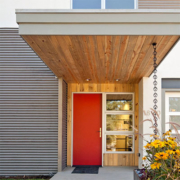Working With An Architect For The First Time
Working with an architect for the first time can be an exciting adventure. You’ve been dreaming about a home built especially for you, and now you’re in the enviable position of making it happen. Poised for greatness, right?
If only there were no fears rolling around in your head, disturbing your sleep!
See if any of these sound familiar:
- I only have so much money, what if my budget is blown and there is nothing I can do about it?!
- There’s this terrifying blank slate in front of me, what if I do it wrong?!
- How much of my time is this going to take? Will I be stressed out trying to make decisions about things I know nothing about?!
- It’s not easy for me to visualize things, what if I end up with something I didn’t want?!
- My partner and I have different aesthetics. Is it even possible to get something we BOTH want?!
- This is such a big investment – I need someone to walk me through everything!
In addition to fears like these, first-time residential clients can be overwhelmed by industry jargon and navigating the design process. This guide to working with an architect will help you understand how we generally structure residential projects, and allay some of the fears you might be experiencing.
There are two Stages in the design process, the first in which the overall design of the house is being explored, and the second in which the design of the house is being refined, documented and built.
Stage I
1> Discovery
In the Discovery phase, we work with you to establish a thorough understanding of your needs, thoughts, ideas, dreams, timeline and budget. This happens in meetings, visits to your existing home or the new site, and through our questionnaire that covers lifestyle and activity. We also begin “listening to the land” to map solar access, site features, views, and other opportunities offered by the unique physical nature of your property. Land surveys, zoning research and code requirements will further inform what we need to know about your site.
Essentially, we are creating – through deep listening and research – the poetic seeds and technical foundation from which to begin our design. If you feel nervous about having a blank slate in front of you, the thoroughness of our Discovery process can put you at ease. We know the important questions to ask, and will provide you with ample opportunity, and many different avenues, to reveal your dreams, ideas and concerns to us. Whether you are a single person, a couple, or a family, whether your “style” is cowboy, artist, or minimalist (or a family with all three), we can and do find ways to blend disparate desires into one home.

2> Schematic Design
Schematic Design is when we begin the conceptual design of the home. With all the information we gathered in Discovery, our creative juices are flowing and our expertise is activated to create an initial Schematic Design. This is presented to you in the form of sketch drawings and, most often, a physical or computer 3D model. Models help you and us visualize the home inside and out. We continue to develop the model as the design progresses, so that you can both understand the design and imagine yourself in it. If it’s a new home, we’ll show you a site plan of where we are suggesting your home be placed, and explain why. Sometimes we even go to your property and stake out the proposed perimeter of the home so you can walk in the spaces physically.
During this phase, we will be pointing out spatial qualities – such as volume, light and views – room layouts, and overall building massing. We also begin to define the energy conservation and renewable energy opportunities, as well as options for a material palette. Later in this phase, we engage with a Structural Engineer to look at the most effective structural approaches to realize the concept.
After we present our initial designs and thinking, we’ll give you our sketch drawings and the site plan so you can take it all in and sleep on it. Thus begins the first feedback loop of many in the process of designing your home. We look forward to your reactions, your questions, your thoughts and ideas about what can take this initial design closer to your dream. When you are unsure or conflicted we will dig deeper and lead you through the decision making process.
Together we further refine the plan to arrive at a Schematic Design package, including sketch level floor plans, elevations, and a more developed 3D model. We also complete a preliminary specifications list, which complements the drawings and begins to enumerate the materials and systems to be used in constructing the home.
At the end of Schematic Design, we all have a really good idea of what your home is going to look like, the size of the rooms, and many of the materials to be used, but there is a lot more detail that needs to be developed on the plan itself. That will come in the Design Development phase, but first there is another feedback loop that we need to engage.

Schematic hand sketch of a large renovation (left), and a 3D computer model of the interior (right). Click the image to see a 3D flythrough of this Schematic level model.

3D computer model of the renovated exterior.
3> Contractor Selection
This feedback loop is about money. The Schematic Design meets your needs and desires, and based on our past experience with construction costs, we think it will meet your budget. Now we need to test that assumption.
Following your approval of the Schematic Design Package, we distribute it to a select group of contractors. You can bring a preferred contractor to the table, or we can recommend contractors from those we’ve had success working with in the past. They review the Schematic Design package with the aim of delivering a preliminary construction cost estimate. We then meet with you and each contractor to discuss their understanding of the project, their experience and practice, and their contract structure. Finally, we meet with you privately to assist in determining the best fit and making an informed contractor selection.
Most likely, your decision about who to hire as the contractor will be partly based on the cost estimate, and partly based on your feeling about working with the contractor – personality, the style of their past work, their experience. Selecting a contractor at this early stage facilitates both a long-term commitment to a shared vision, and an integral means of confirming general budget compliance before we move forward into Stage II. The leadership team is now in place to carry the project to fruition.
Between now and the time construction begins on the home, the construction cost will be firmly held in mind by us. If you suggest a change to the design that will increase the construction cost, we will tell you. Later, when the contractor gives you a final bid for building the house, we can advise you about elements or materials that could be changed to help you stay within budget.
Keep in mind, the contractor at this point has only given a preliminary construction cost. Now that the contractor is on board with the project, we will all be in communication to help you make decisions to keep your project within budget, while as a team, we work to retain the architectural vision in which we are all vested.

Ryan Wither of Buildwell and Architect Rich Keilman discuss a Boulder renovation.
Stage II
4> Design Development
In Design Development we begin with the approved Schematic Design package and start developing it in a way that furthers clarity of systems, details, and materials. We also begin conversations with necessary consultants such as electrical, mechanical, lighting, and landscape, and continue our discussions with the structural engineer. We invite our client into discussion and decisions about energy, comfort systems, and further evolution of materials and architectural details.
As this phase progresses, the contractor will update and refine the cost estimate to ensure we stay on budget. We will also engage the contractor to review our details and specifications for constructability. The ultimate goal of Design Development is to complete all design related work in preparation for the Construction Documents phase.


5> Interior Architecture
Interior Architecture involves the selection of fixtures and finishes such as plumbing, tile, lighting, flooring, cabinetry, paints and plasters. Providing this service in-house greatly benefits the overall experience and integrity of your home. Since it will be implemented by a team so intimately familiar with the vision, the home will ultimately feel – both inside and out – like a cohesive and collected whole.
There are many decisions that you will make during the design process. Some people find joy in exploring the different options, prices, and features. Some people find this stressful because they don’t make decisions easily, or they are less confident because they don’t have past experience to pull on. Both interiors and exteriors are areas where you will spend significant time making decisions. These decisions can be spread out over months instead of all at one time. Rest assured, we always help our clients with technical information, advice on sustainability and usability, and we can be asked to give subjective opinions on colors, fixtures and finishes too.

6> Construction Documents
In the Construction Documents phase, technical drawings and specifications are drafted which set forth the requirements for permitting and constructing your home. These documents will serve to communicate the design intent to the contractor and subcontractors, and will bring together the architectural, interiors, structural, mechanical, electrical, and landscape aspects of the project into a clear building package. During this process, we continue to communicate with your contractor to address constructability and construction costs. A preliminary set of Construction Documents is used to submit the project for a building permit review. Additional work on the preliminary set fleshes out the myriad custom details that will make your home an artful and technical expression of our shared vision.
7> Construction Observation
Construction Observation is often the phase that ensures a project’s ultimate success. It is also where the importance of the ongoing collaborative relationship between architect, client, and contractor becomes apparent. During construction, we visit the site on a weekly or biweekly basis, acting as your – and the design’s – representative. We also advise and consult with you and with the contractor, staying involved in problem solving, clarification and construction field observations. Our continued involvement through this key phase ensures that the finished home you move into is a well crafted, faithful manifestation of the beginning poetic seeds and continued vision that we created together. While you may have worked with our Interiors department to select lighting, plumbing fixtures, and finishes earlier in the design process, we can also assist with furniture, window treatments, and accessories when your home is complete.

This was an amazing home to monitor during construction! Click to see photos of the completed house.
We hope this guide has taken some of the mystery, and some of the fears, out of working with an architect for the first time. We don’t expect clients to know anything about architecture when they come to us. We do hope they want to participate fully in the co-creative process, and have resonance with the kind of architecture we passionately pursue. We take it from there, leading and juggling and educating until your dream has manifested before your eyes.

















